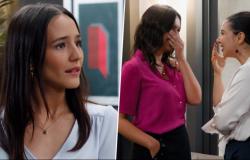-
According to Zendesk, at least 70 percent of brands remember the special brands that marked their lives.
-
Users captured the moment in which you can see the new final destination advertising, which caused reactions.
-
80 percent know that its notalgia influences purchasing habits.
In social networks circulated the moment in which the advertising of the new final destination film was captured, an issue that caught the attention of people after being as unexpected, since it revived the fear of fans of the saga.
At least 70 percent of people say they remember the most special brands of their life, while 80 percent ensure that nostalgia influences their purchase habits, according to Zendesk.
Through social networks, a video showed a spectacular mobile promotional promotional film, which makes direct allusion to the iconic log truck scene.
The activation was seen on a highway, where a truck circulated with an overlapping structure that simulated a huge cargo of trunks, almost identical to the one that appears in the most remembered delivery of the saga.
This action was interpreted as a marketing master play, not only by the visual wink so direct to fans, but for the use of movement in motion to generate impact and conversation.
In addition, in the comments, several users admitted that they had to advance their maneuver on the road “just in case”, remembering the collective trauma left by that original scene.
The final destination return already generates conversation before reaching Salas, and this activation seems to confirm that the campaign seeks to provoke the same intense emotions that defined the franchise. For many, fear returned to highways, and not precisely because of traffic.
@rhyszxc spotted in Commonwealth. promotion, hellaur??? #finaldestination #finaldestinationbloodlines ♬ The Final Destination – Brian Tyler
Marketing de Nostalgia
The advertising that appeals to nostalgia has established itself as an emotionally powerful tool for brands, since it connects with positive memories of the past and generates a feeling of familiarity that influences purchasing decisions.
This type of strategy is usually based on visual, musical or narrative elements that refer to specific times, managing to activate deep emotional ties and arouse the desire to revive moments that the consumer associates with well -being, innocence or identity.
The nostalgic has the ability to overcome generational barriers: while adults feel a direct connection with what they lived, the youngest are attracted to the charm of the “retro” as an aesthetic or cultural expression.
In this context, many campaigns bring Jingles back, old packaging, emblematic characters or discontinuous products that reinforce the authenticity of the brand and feed the conversation into networks. Nostalgia, well used, not only generates emotional impact, but also differentiation and brand remembrance.
Pepsi
A real example is the Pepsi campaign in Mexico that relaunched the iconic glass bottle with vintage design and the return of the motto “Pepsi is for those who know what they want.”
This action directly appealed to those who grew in the 80s and 90s, but also connected with new generations interested in the classic, increasing the visibility of the brand with an effective mixture of tradition and trend.
Read also:
El Eternauta, la serie de Netflix, ¿product placement o branded content?
Ferrero Rocher Squares and Nutella with peanuts: thus seeks Ferrero “Americanizar” its brands
Razer launches a creator of immersive experiences for gamers






